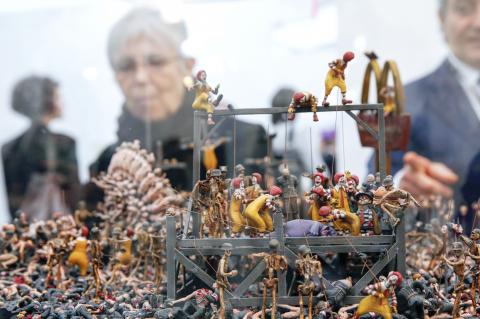Inside the Frieze Art Fair on New York’s Randall’s Island, there’s a hotel with two beds so guests can sleep among the artworks for as much as US$375 a night.
A security guard will keep tabs on the slumber party to make sure no one is wandering around the white serpentine-tent housing 190 contemporary-art galleries from 28 countries. They can hang out in this art installation and watch hotel-themed films such as Grand Hotel, the 1932 Greta Garbo classic. Breakfast and dinner will be served.
The art world elite including billionaire collectors Eli Broad and Alice Walton are expected to converge today on the fair, a short car or ferry ride from Manhattan. Now in its third year, Frieze, which ends tomorrow, is cementing its role in New York as a hip marketplace for emerging and blue-chip art.

Photo: Reuters/Shannon Stapleton
Wealthy collectors can grab a US$2,000 cast bronze champagne corkscrew by emerging artist Chris Bradley or drop US$650,000 on a Donald Judd minimalist box. Frieze also commissioned surprising art projects like the sleepovers and organizing brainy talks, which this year will include a conversation between members of Russian punk band Pussy Riot and New Yorker editor-in-chief David Remnick.
“I always keep in mind it’s an art fair,” said Cecilia Alemani, who coordinated Frieze Projects, the site-specific artworks commissioned for the fair such as the Al’s Grand Hotel. “It’s not just collectors. People can listen to great talks or a concert or just enjoy an afternoon on the lawn.”
Auctions, Fairs
The fair coincides with two weeks of semi-annual auctions in New York, which are expected to sell as much as US$2.3 billion of art. It also anchors at least eight other art fairs including Pulse, New Art Dealers Alliance (NADA) and mini-fairs Seven and Salon Zurcher.
Frieze, which started in 2003 in London, where it will hold its next edition in October, is considered one of the world’s three most important contemporary-art fairs, along with Art Basel in Switzerland in June and Art Basel Miami Beach in December.
“Most collectors believe it’s a must-see event,” said Wendy Cromwell, director of New York-based art advisory firm Cromwell Art LLC. “They have a really nice high-low strategy, with a good representation of high-end art and emerging art. It’s taken them three years to get to this point.”
Solo Shows
More than 20 galleries are dedicating their booths to solo artist presentations, ranging from American veteran Ed Ruscha at Gagosian gallery to emerging Brit Eddie Peake at Lorcan O’Neill.
New York’s Gladstone Gallery will show more than 200 drawings by Carroll Dunham created between 1979 and 2014. David Kordansky Gallery from Los Angeles is showing Sam Gilliam

In the March 9 edition of the Taipei Times a piece by Ninon Godefroy ran with the headine “The quiet, gentle rhythm of Taiwan.” It started with the line “Taiwan is a small, humble place. There is no Eiffel Tower, no pyramids — no singular attraction that draws the world’s attention.” I laughed out loud at that. This was out of no disrespect for the author or the piece, which made some interesting analogies and good points about how both Din Tai Fung’s and Taiwan Semiconductor Manufacturing Co’s (TSMC, 台積電) meticulous attention to detail and quality are not quite up to

April 21 to April 27 Hsieh Er’s (謝娥) political fortunes were rising fast after she got out of jail and joined the Chinese Nationalist Party (KMT) in December 1945. Not only did she hold key positions in various committees, she was elected the only woman on the Taipei City Council and headed to Nanjing in 1946 as the sole Taiwanese female representative to the National Constituent Assembly. With the support of first lady Soong May-ling (宋美齡), she started the Taipei Women’s Association and Taiwan Provincial Women’s Association, where she

Chinese Nationalist Party (KMT) Chairman Eric Chu (朱立倫) hatched a bold plan to charge forward and seize the initiative when he held a protest in front of the Taipei City Prosecutors’ Office. Though risky, because illegal, its success would help tackle at least six problems facing both himself and the KMT. What he did not see coming was Taipei Mayor Chiang Wan-an (將萬安) tripping him up out of the gate. In spite of Chu being the most consequential and successful KMT chairman since the early 2010s — arguably saving the party from financial ruin and restoring its electoral viability —

It is one of the more remarkable facts of Taiwan history that it was never occupied or claimed by any of the numerous kingdoms of southern China — Han or otherwise — that lay just across the water from it. None of their brilliant ministers ever discovered that Taiwan was a “core interest” of the state whose annexation was “inevitable.” As Paul Kua notes in an excellent monograph laying out how the Portuguese gave Taiwan the name “Formosa,” the first Europeans to express an interest in occupying Taiwan were the Spanish. Tonio Andrade in his seminal work, How Taiwan Became Chinese,